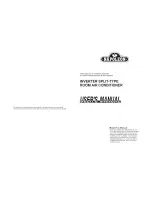
■
English
6
5.
Purging air and checking gas leakage.
•
When piping work is completed, it is necessary to purge the air and check for gas leakage.
WARNING
1) Do not mix any substance other than the specified refrigerant (R410A) into the refrigeration cycle.
2) When refrigerant gas leaks occur, ventilate the room as soon and as much as possible.
3) R410A, as well as other refrigerants, should always be recovered and never be released directly into the environment.
4) Use a vacuum pump for R410A exclusively. Using the same vacuum pump for different refrigerants may damage the vacuum
pump or the unit.
•
If using additional refrigerant, perform air purging from the refrigerant pipes and
indoor unit using a vacuum pump, then charge additional refrigerant.
•
Use a hexagonal wrench (4mm) to operate the stop valve rod.
•
All refrigerant pipe joints should be tightened with a torque wrench at the specified
tightening torque.
*1. Pipe length vs. vacuum pump run time.
*2. If the compound pressure gauge pointer swings back, refrigerant may have water content or a loose pipe joint may exists.
Check all pipe joints and retighten nuts as needed, then repeat steps 2) through 4).
1) Connect projection side of charging hose (which comes from gauge manifold) to gas stop valve
’
s service port.
2) Fully open gauge manifold
’
s low-pressure valve (Lo) and completely close its high-pressure valve (Hi).
(High-pressure valve subsequently requires no operation.)
3) Do vacuum pumping and make sure that the compound pressure gauge reads
–
0.1MPa (
–
76cmHg)*1.
4) Close gauge manifold
’
s low-pressure valve (Lo) and stop vacuum pump.
(Keep this state for a few minutes to make sure that the compound pressure gauge pointer does not swing back.)*2.
5) Remove caps from liquid stop valve and gas stop valve.
6) Turn the liquid stop valve
’
s rod 90 degrees counterclockwise with a hexagonal wrench to open valve.
Close it after 5 seconds, and check for gas leakage.
Using soapy water, check for gas leakage from indoor unit
’
s flare and outdoor unit
’
s flare and valve rods.
After the check is complete, wipe all soapy water off.
7) Disconnect charging hose from gas stop valve
’
s service port, then fully open liquid and gas stop valves.
(Do not attempt to turn valve rod beyond its stop.)
8) Tighten valve caps and service port caps for the liquid and gas stop valves with a torque wrench at the specified torques.
Pipe length
Up to 15 metres
Run time
Not less than 10 min.
Compound
pressure gauge
Pressure
meter
High-
pressure
valve
Low-pressure
valve
Vacuum pump Service port
Liquid
stop
valve
Valve caps
Gas stop valve
Charging
hoses
Gauge
manifold
Содержание RXB25B5V1
Страница 13: ...English 12...
Страница 25: ...12 T rk e...
Страница 26: ...1 R410A O p p p p p p p p p p p p p p p...
Страница 27: ...2 1 2 3 4 5 6 7 3 3 8 9 1 2 3 4 B 1 99 2 1 51 4 99 2 1 692 5 4 5 5 1 7 9 97 9 8 97 139 1 696 2 134...
Страница 33: ...8 1 2 3 4 15 1 2 3 4 30 1 2 KF 1J7 BF CJ7 54F F1 JP5F 54F F1F C 7 54GR KF5 J 9 KF 1J7 9 5 1J7 54F F1...
Страница 36: ...11 1 1 1 1 2 1 2 26 C 28 C 20 C 24 C 3 1 2 26 C 28 C 3 1 3 2 RC...








































